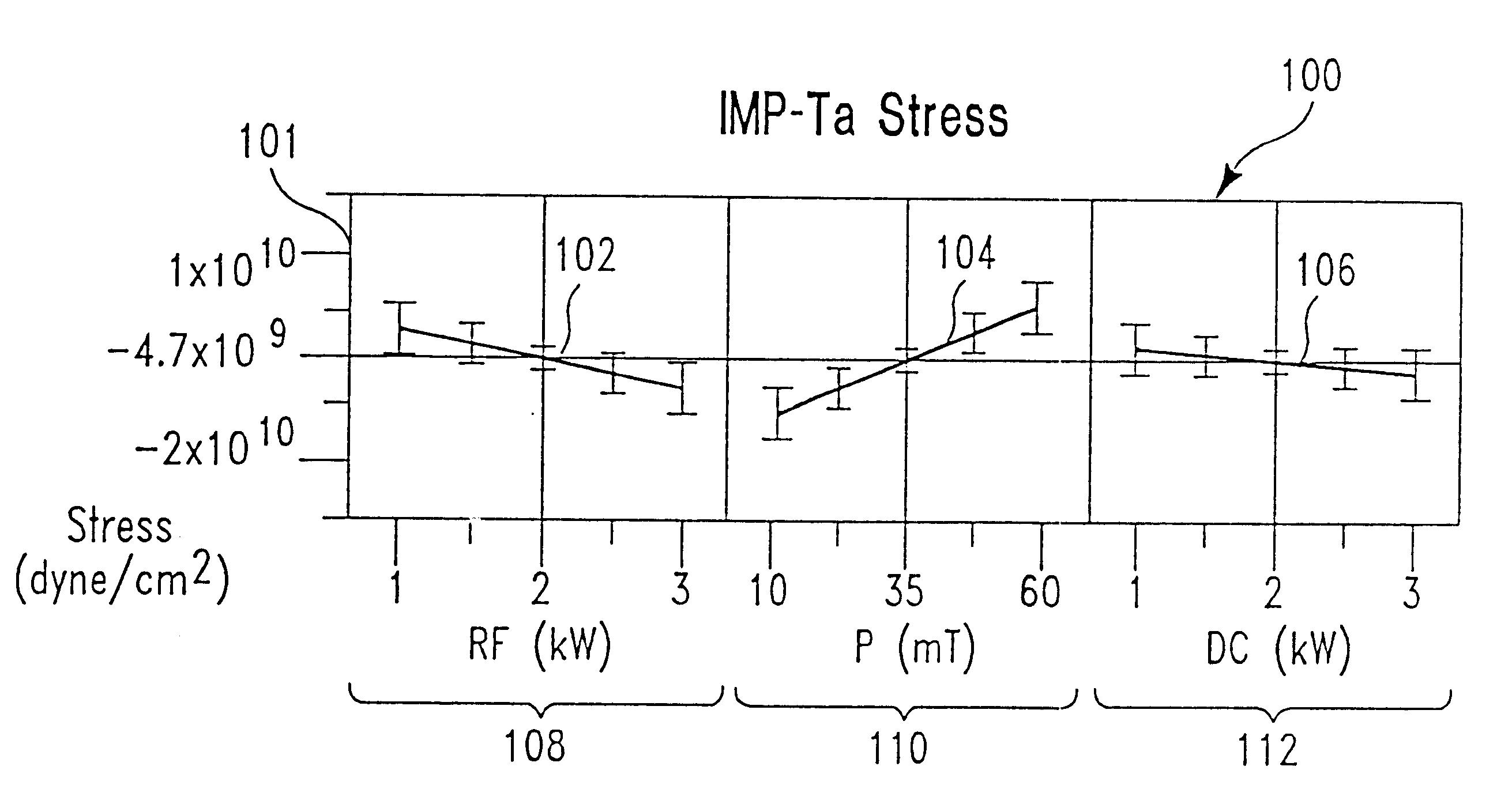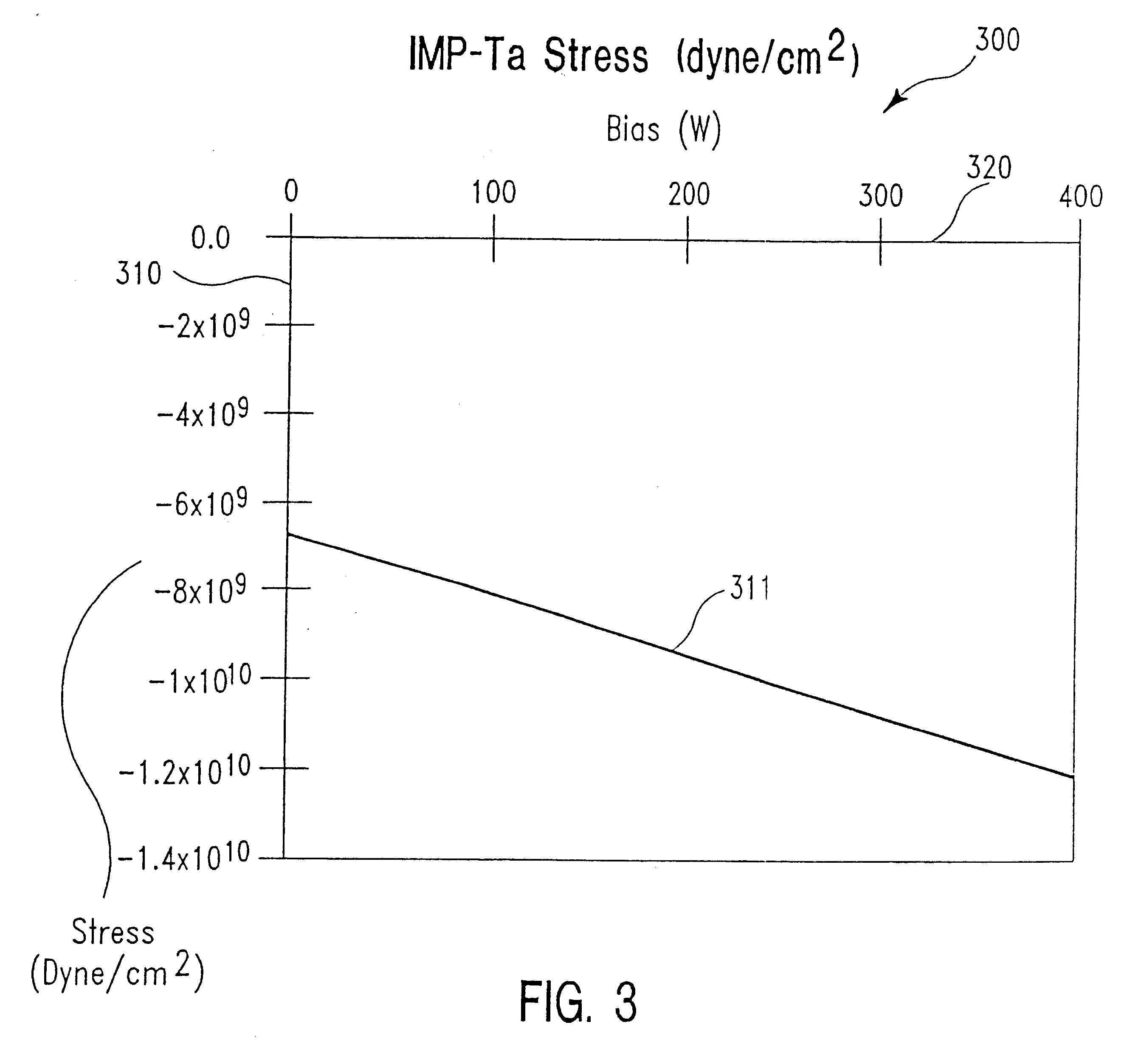Stress tunable tantalum and tantalum nitride films
a technology of tantalum and nitride, applied in the field of tantalum and tantalum nitride films, can solve problems such as feature distortion or even deformation on the substrate (typically a silicon wafer) surfa
- Summary
- Abstract
- Description
- Claims
- Application Information
AI Technical Summary
Benefits of technology
Problems solved by technology
Method used
Image
Examples
example two
When IMP-sputtered tantalum film was produced, a high density, inductively coupled RF plasma was generated in the region between the target cathode and the substrate by applying RF power to a coil (having from 1 to 3 turns) over a range from about 400 kHz to about 13.56 MHZ (preferably about 2 MHZ). Two hundred (200) mm sample surfaces were IMP sputter-deposited at a sample surface temperature of about 25.degree. C., in argon, at pressures ranging from about 10 mT to about 60 mT. The distance from the cathode to the sample was typically about 14 cm. The DC power to the tantalum target was adjusted over a range from about 1 kW to about 8 kW (preferably, about 1 kW to about 3 kW). The wattage to the RF power coil was adjusted over a range from about 1.0 kW to about 5 kW (preferably, about 1.0 kW to about 3 kW). An AC bias power ranging from about 0 W to about 500 W was used.
FIG. 1 shows a graph 100 of the residual film stress 101 of the tantalum film in dynes / cm.sup.2, as a function o...
example three
The effect of the increase in ion bombardment of a depositing film surface, which can be achieved by increasing the DC offset bias voltage of the substrate onto which the film is deposited, is illustrated in FIG. 3. Graph 300 shows the residual stress 311 in dynes / cm.sup.2 310 as a function of the AC bias power 320 in Watts. The corresponding substrate DC offset bias voltage ranges from about 0 V to about -150 V.
example four
When tantalum nitride films are produced, the structure of the tantalum nitride depends on the amount of nitrogen in the tantalum nitride compound (film). FIGS. 4 and 5 show the chemical composition and resistivity of tantalum nitride films produced using gamma sputtering and IMP sputtering techniques, respectively. The chemical composition (atomic nitrogen content) of the film is shown as a function of the nitrogen gas flow rate to the process chamber in which the TaN.sub.x film is produced.
FIG. 4, graph 400, shows the nitrogen content 410 of the gamma-sputtered tantalum nitride film in atomic % 413, as a function of the nitrogen flow rate 416 in sccm to the process vessel. A two hundred (200) mm diameter sample surface was gamma sputter-deposited at a sample surface temperature of about 25.degree. C., in an argon / nitrogen atmosphere, at a pressure of about 1.5 mT, where the argon gas feed was about 15 sccm, and the nitrogen flow rate 416 was as shown on graph 400. The "throw" dist...
PUM
| Property | Measurement | Unit |
|---|---|---|
| temperature | aaaaa | aaaaa |
| temperature | aaaaa | aaaaa |
| temperature | aaaaa | aaaaa |
Abstract
Description
Claims
Application Information
 Login to View More
Login to View More - R&D
- Intellectual Property
- Life Sciences
- Materials
- Tech Scout
- Unparalleled Data Quality
- Higher Quality Content
- 60% Fewer Hallucinations
Browse by: Latest US Patents, China's latest patents, Technical Efficacy Thesaurus, Application Domain, Technology Topic, Popular Technical Reports.
© 2025 PatSnap. All rights reserved.Legal|Privacy policy|Modern Slavery Act Transparency Statement|Sitemap|About US| Contact US: help@patsnap.com



